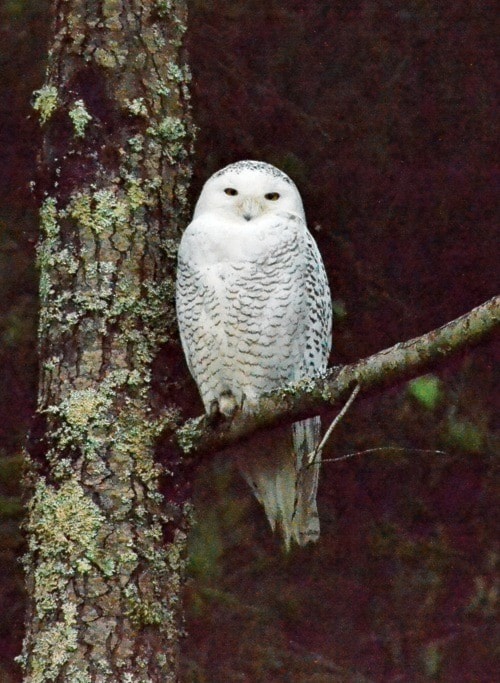In an environment where snow is rare, one isn’t expecting to see a snowy owl.
But that’s exactly what Joanne Jonas-Mcrae and a friend saw just after noon Dec. 10, sitting quietly on a tree branch at the end of a driveway on Kenwill Street in north Nanaimo.
It sat there for a good part of the day, long enough for Jonas-Mcrae and her friend to snap several photos of the rare visitor.
“It was unbelievable, it was quite a sight to see,” said Jonas-Mcrae. “I’ve never seen anything like it.”
Temperate rain forest isn’t the bird’s first choice for environment – it prefers the Arctic tundra so it can hunt lemmings and mice with the advantage of camouflage.
Colin Bartlett, owner of the Backyard Wild Bird and Nature Store, said there have been a half dozen reports of snowy owl sightings in Nanaimo over the past couple of weeks, though no one is certain how many are around.
Bartlett said the bird’s arrival from its regular habitat hundreds of kilometres to the north presents a couple of theories.
“One possibility is that their main food source, lemmings, has crashed, so there is not a lot of food, so the adults will establish territory and a lot of the juveniles get kicked out and they move south trying to find food,” said Bartlett. “The second reason is that the owls had a great population of food source which resulted in a great nesting season and then they overpopulated, and again some get kicked out.”
Bartlett said it’s the second consecutive year snowy owls have visited Nanaimo, which may suggest there is plenty of food up north.
In this environment, however, snowy owls have a harder time hunting and starvation is a possibility – grass is longer, underbrush is more dense and prey is better hidden.
With that possibility, Jonas-Mcrae left out a dish of salmon for her feathered friend, which it happily took before flying off to parts unknown.
“We called a few different bird places, including the North Island Wildlife Recovery Association in Errington, because we were concerned about it,” said Jonas-Mcrae. “It was really cool to see but it’s also a little bit sad because this isn’t where it’s supposed to be.”
Feeding the owls, or any other wild animal, however, is not advisable, said Trudy Chatwin, species at risk biologist with the provincial Ministry of Environment, even if the animal seems emaciated.
“I know it’s hard and people worry about them, but feeding them – and I’ve never heard of an owl eating salmon before – can be even more harmful to them. It’s not their normal food.”
Chatwin said a snowy owl was found dead near Diver Lake last week and was turned in to the ministry. Several owls have also been found dead in Prince George over the past few weeks. Residents in Nanaimo who come across a dead owl should phone 250-751-3100.
“It’s unfortunate but the owls that are here have come a long way, they are probably starving, and being juveniles, aren’t as good at hunting as the mature ones, so they do face some challenges,” she added.
Birdwatchers have also been flocking to Boundary Bay in Vancouver, said Bartlett, where several snowy owls have settled in for the winter.
Experts recommend giving the birds plenty of space so they aren’t startled – they often fly fairly low searching for prey so urban features, such as vehicles, can be a threat.
Snowy owls are the largest of North American owls with a weight up to three kilograms and a wingspan of 1.5 metres.
Though they nest in the Arctic tundra, they are nomadic and sometimes venture south throughout Canada in the winter months, looking for areas like coastal dunes and prairie that appears similar to tundra. In the past they have been reported as far south as Texas.
Their current conservation status is listed as ‘least concern.’
